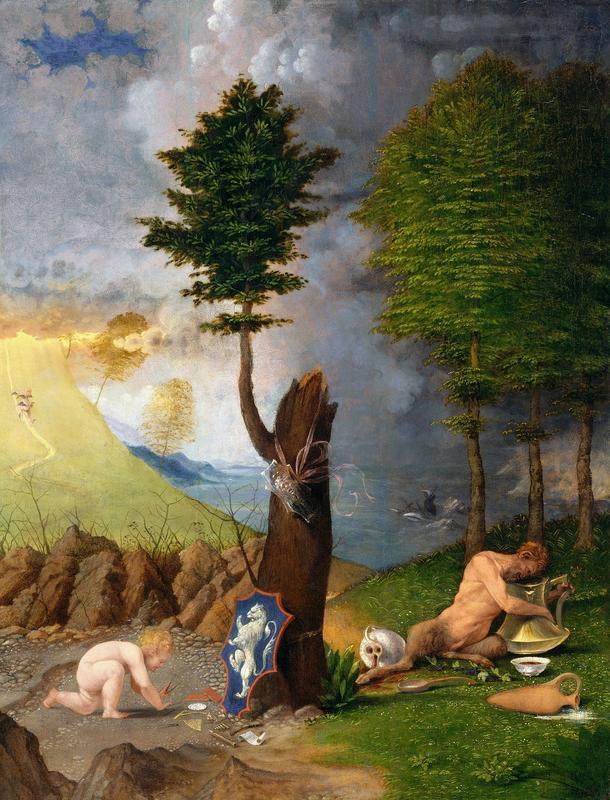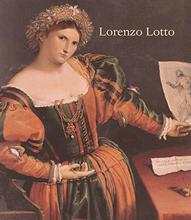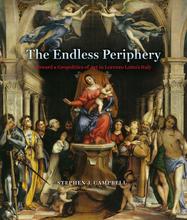More about Allegory of Virtue and Vice
- All
- Info
- Shop

Sr. Contributor
Depending on the circumstances, it’s not usually a tough choice to choose between right or wrong, or even sometimes safe but boring versus risky but exciting; however, as we can see in Lorenzo Lotto’s painting, Allegory of Virtue and Vice, the choice may not be as clear-cut.
On the one side we have a pure-looking little putto putzing around with different symbols and tools of “virtue,” while on the other side (the Dark Side, perhaps?), we have a likely drunken satyr, who looks a little rough around the edges, staring in to his possibly empty vessel of wine, with other containers of liquid spilled on the ground next to him.
There is a lot of symbolism contained in this painting, on display at the National Gallery of Art in Washington D.C., and we’ll get to that, but it should first be noted what this painting actually was: a protective cover for another painting. Lotto also painted a portrait of his first patron, Bishop Bernardo de' Rossi, the bishop of Treviso, which is now in the collection of the National Museum of Capodimonte, in Naples.
The Allegory painting would have been attached to this portrait, and when opened to reveal the painting beneath, an inscription on the reverse of Allegory would also have been revealed, with Rossi’s age, title, and residence, as well as when Lotto painted it (July 1, 1505). Covers such as this were a fairly common addition to a portrait during this time, and would often contain clues to the subject portrait that it was protecting underneath.
So how about those symbols then? To start with, the shield leaning against the tree has Bishop de’ Rossi’s coat-of arms and it naturally faces the virtue side, which is divided from the vice side by the tree, which itself shows new, fresh growth on the left side, with a ragged, broken trunk leaning towards the other side. The items that the putto is pondering include books, symbolizing wisdom, with the rest representing the liberal arts and sciences with flutes (music), compasses (architecture), a scroll (poetry), a protractor (geometry), along with a couple of other items.
Meanwhile, on the right side, the satyr (sometimes identified as Silenus), while lolling on lush green grass, is oblivious to the sinking ship and stormy waters behind him; there is even a possible sea monster to the right of the ship. Then there’s that weird clear shield with a face on it hanging from the tree; this has been described as a “crystal escutcheon with a gorgon’s head” that indicates “petrification and death.”
Lotto painted Allegory and the portrait shortly after Bishop Rossi survived an attempt on his life; apparently Rossi may not have always played well with others, mainly some of the authorities in Venice, which would later lead to his moving from Venice to Rome. This could have provided a purpose behind Lotto’s use of this particular allegory, to show that Rossi had wisely chosen the path of scholarship, learning, and of course, a life of virtue, which would lead him on the path to heaven, where the other putto (with wings) is heading, all the while prevailing over his enemies.
Lorenzo Lotto may have been influenced by another allegorical image, Albrecht Dürer’s, Hercules at the Crossroads of 1498. This print would have been available in Treviso during Lotto’s time and also uses a tree as a dividing point where Hercules must choose between the two paths of virtue and vice, and unsurprisingly, there’s another satyr hanging out (this time with a nude woman). Allegories and symbols can be tricky; even Lotto himself was not always clear on some of his symbolism, so we’ll let him have the last word on this, as he wrote in a letter attempting to clarify his work: “As for the designs of the covers, you should know that since they do not follow any written program, they must be interpreted by imagination.”
Sources
- Brown, David Alan, Sylvia Ferino Pagden, Jaynie Anderson, and Barbara Hepburn. Berrie. Bellini, Giorgione, Titian, and the Renaissance of Venetian Painting. Washington: National Gallery of Art, 2006.
- Humfrey, Peter. Lorenzo Lotto. New Haven, CT: Yale University Press, 1997.
- Jacobsen, Michael A. "The Meaning of Mantegna's Battle of Sea Monsters." The Art Bulletin 64, no. 4 (1982): 623-29. Accessed February 23, 2020. doi:10.2307/3050273.
- Nova, Alessandro. "Lorenzo Lotto. Bergamo." The Burlington Magazine 140, no. 1143 (1998): 412-14. Accessed February 20, 2020. www.jstor.org/stable/888078.
- https://www.the-athenaeum.org/art/detail.php?ID=39152
- https://repository.upenn.edu/cgi/viewcontent.cgi?article=1014&context=p…
Featured Content
Here is what Wikipedia says about Allegory of Virtue and Vice (Lotto)
The Allegory of Virtue and Vice is an oil-on-panel painting by the Italian High Renaissance painter Lorenzo Lotto, dating to 1505. It is housed in the National Gallery of Art in Washington, DC, United States.
Check out the full Wikipedia article about Allegory of Virtue and Vice (Lotto)














